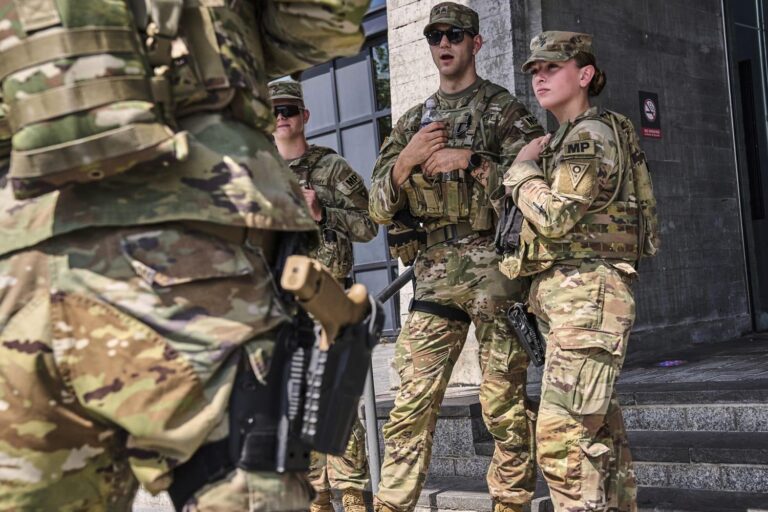Armed National Guard in Washington, D.C.: A New Chapter in Capital Security
In response to rising security challenges, National Guard units deployed in Washington, D.C., have now been granted permission to carry firearms, a move confirmed by defense authorities. This policy shift aims to enhance the protective measures around critical federal landmarks and government operations amid an increasingly complex threat landscape. By equipping troops with weapons, officials seek to improve rapid response capabilities and reinforce the overall security posture within the capital.
Highlights of this policy update include:
- Improved readiness for immediate action against security threats
- Seamless collaboration with local police and federal agencies
- Strict firearm handling and usage guidelines
- Ongoing, rigorous training programs to ensure proficiency and responsibility
| Aspect | Details |
|---|---|
| Authorized Personnel | Active-duty National Guard members stationed in D.C. |
| Armament Scope | Standard-issue firearms with mandatory certification |
| Security Goal | Fortify defense against urban security threats |
| Partner Agencies | Metropolitan Police Department and FBI |
Rationale and Protocols Behind Arming National Guard Troops
The authorization to arm National Guard personnel in Washington, D.C., follows a thorough security evaluation that identified heightened risks during recent incidents. Defense officials describe this as a precautionary strategy designed to enhance troop preparedness and safeguard both service members and civilians. Emphasis has been placed on implementing comprehensive rules of engagement and strict weapon use policies to prevent unnecessary escalation while maintaining public order.
Key components of the accompanying measures include:
- Advanced Training: Troops receive specialized instruction in crowd management and conflict de-escalation techniques.
- Command Authorization: Firearm deployment requires approval from senior officers to ensure accountability.
- Interagency Communication: Continuous coordination with local law enforcement to synchronize operational responses.
- Dynamic Security Assessment: Ongoing monitoring and adjustment of security protocols based on real-time intelligence.
| Measure | Purpose | Status |
|---|---|---|
| Troop Training | Ensure responsible firearm use and effective crowd control | Completed for all deployed units |
| Rules of Engagement | Establish clear limits to prevent misuse of force | Strictly enforced |
| Command Authorization | Centralize decision-making for weapon discharge | Active and monitored |
Impact on Public Safety and Crowd Control During Major Events
The introduction of armed National Guard troops in Washington, D.C., marks a significant evolution in managing public safety during high-profile gatherings. The visible presence of armed personnel is intended to deter potential threats and enable swift intervention if emergencies arise. Nevertheless, this development also prompts important discussions about balancing enhanced security with the protection of civil rights and preserving the atmosphere of peaceful assembly.
Modern public safety strategies now integrate this armed presence with cutting-edge surveillance technologies, real-time communication networks, and coordinated efforts among federal, state, and local agencies. The goal is to maintain a controlled yet approachable security environment that minimizes the risk of conflict escalation while ensuring rapid response capabilities. The table below outlines the core elements of this updated crowd management framework:
| Component | Description | Objective |
|---|---|---|
| Armed National Guard Patrols | Visible armed units patrolling key public areas | Deterrence and rapid crisis response |
| Unified Communication Systems | Integrated channels for coordinated action among agencies | Streamlined incident management |
| Advanced Surveillance | Deployment of cameras and aerial drones for live monitoring | Early identification of potential threats |
| Community Outreach | Engagement with event organizers and local stakeholders | Mitigation of tensions and misinformation |
Recommendations for Training and Accountability of Armed National Guard Personnel
Security experts and defense analysts stress the importance of comprehensive and ongoing training programs for National Guard troops now authorized to carry firearms in Washington, D.C. Beyond fundamental weapons proficiency, these programs should incorporate realistic scenario-based drills, stress resilience training, and stringent engagement protocols. Such preparation is critical to ensure that troops can effectively manage high-pressure situations without compromising public safety or civil liberties.
Robust oversight is equally essential to uphold transparency and public confidence. Recommended measures include:
- Regular mental health assessments to verify fitness for armed duty.
- Independent review panels to oversee adherence to rules of engagement and conduct in the field.
- Enhanced collaboration with local law enforcement to harmonize operational standards and accountability.
| Training Focus | Suggested Improvement | Anticipated Benefit |
|---|---|---|
| Use-of-Force Guidelines | Advanced decision-making simulations | Minimized risk of excessive force incidents |
| Crisis Communication | De-escalation and conflict resolution workshops | Enhanced interactions with civilians |
| Transparency and Accountability | Real-time body camera monitoring | Improved oversight and expedited investigations |
Conclusion
The decision to arm National Guard troops in Washington, D.C., represents a strategic adaptation to evolving security challenges in the nation’s capital. Officials reaffirm their dedication to protecting public safety while respecting civil liberties through rigorous training, clear protocols, and interagency cooperation. As this policy unfolds, the public is encouraged to stay informed via official sources for the latest developments. For continuous updates, follow trusted news outlets such as ABC News.





